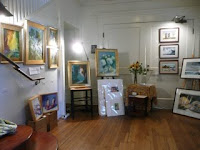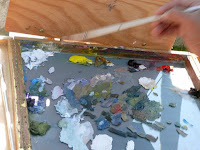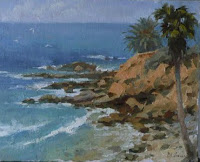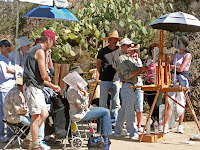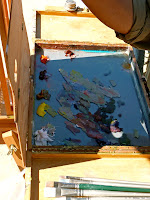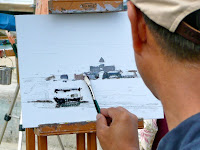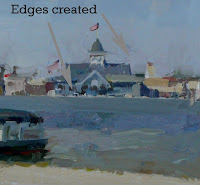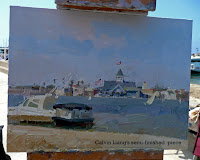
I attended
Mian Situ's demo organized by the California Art Club at the historic
Blinn House in Pasadena. It was a real treat. But can I say how much it annoys me when people use the intermission to plant themselves in front of the canvas-in-progress? I mean, taking a picture or two is expected but just chit-chat and ignore the crowds behind you is kind of rude and won't make you paint better. There , I let that out. Needless to say, attendance was high.

The model was Barbara Chung, part of the California Art Club team. Video services provided by Karen and Glenn Winters which makes me think there will be an available DVD in the future.
Mian Situ was extremely sweet and funny during the whole thing. His palette consisted of the usual suspects but his array of earth colors was a bit wider than usual.
-Titanium white
-Cadmium Yellow
-Cadmium Red
-
Alizarin Crimson
-Yellow Ochre
-Burnt Sienna
-Terra
Rossa-Ultramarine Blue
-Cerulean Blue
-Sap Green (even though his green today was more like a light green)
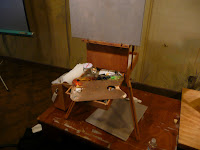
His smaller brushes were of the
mongoose Rosemary brand name. The bigger ones were bristle and his brand of choice varies.
His canvas was a regular acrylic primed canvas primed with a bit of grey.
He normally will paint without primer and take his time to build up the layers but, for the demo, he needed something ready made.
His medium is none, he thinks paints have enough oil to be handled without.
Mian started with some deliberate markings. Very soon, the likeness of the model was dead-on.
Mian applied the painting blocking first the biggest masses and broader areas. His brushwork is very interesting to watch. He doesn't hesitate to use paper towels,knife, fingers and all kinds of brush application techniques to keep it moving.


He created the hair and shirt masses first. The lighter and darker areas first I suppose. He blocked the color quickly and loosely. He pointed out is is not that important to try for accuracy in the actual color but rather to pick whichever one feels right and make it work inside the canvas. The way he created soft and hard edges was like magic, really. trying to explain it is like trying to explain music. One thing that stood out is how his work was extremely accurate and , like I said, deliberate. It seems that he had a plan for every stroke as he would go back on certain areas after every once in a while and just apply that softness or accent that made it all work.
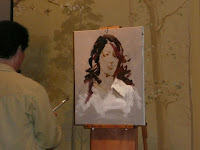
Once the cleaner colors were applied,
Mian felt very comfortable mixing
nuanced tones to connect and enhance the areas. The nose bridge , the sap green and burnt sienna mix in neck and shadow area were applied soon and remained the "big notes' in the actual face. The lips' tones came soon thereafter and a few of the chiseling features . Everything else was done in more muted notes and brush sculpting.
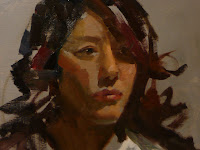
This painting bellow is the result of exactly one hour and twenty minutes of work. Pretty amazing if you ask me.
And the model's likeness is just incredible. He admits it might take days for him to finish a figure in his studio but what does this man consider finished?
Mian is kind of famous for his beautiful "historical" or "narrative" pieces. He
researches these quite a bit and sometimes they feel a bit distant. he uses photographs as reference as well. So it was really nice to see him paint "
alla prima"

 This other piece was painted on location, the house of the client. He liked the view of downtown Los Angeles from the porch, and it was quite a view. He only asked for some minor adjustment to the sky color after he saw the final piece.
This other piece was painted on location, the house of the client. He liked the view of downtown Los Angeles from the porch, and it was quite a view. He only asked for some minor adjustment to the sky color after he saw the final piece.






